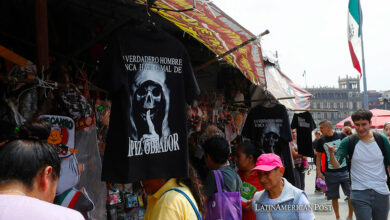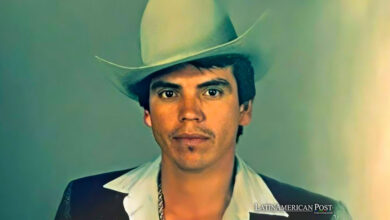The Lithium triangle has Latin America with a square head
This element found naturally on our planet has become the gasoline of tomorrow, as it mainly serves to manufacture the batteries of our devices.

Lithium Triangle, composed of Bolivia, Chile and Argentina. / Photo: LatinAmerican Post
LatinAmerican Post | Alberto Castaño
Listen to this article
Leer en español: El triángulo del Litio tiene a Latinoamérica con la cabeza cuadrada
Lithium is an element of the periodic table, which we who memorized in the school useless things, we found under hydrogen in the first group of elements. This element found naturally on our planet has become the gasoline of tomorrow, as it mainly serves to manufacture the batteries of our cell phones, laptops and the increasingly desired electric cars.
The world changes every day and many times we do not keep up with its change, but with the exploitation of lithium, old combustion engine vehicles that are fed with hydrocarbons such as gasoline or diesel can leave the circulation. In a few words, lithium is green gasoline or, rather, white gasoline, because that is the color it has when it is extracted and converted into lithium carbonate, the presentation in which it is commercialized internationally and whose price has been increasing steadily since years ago thanks to its greater demand.
85% of the world's lithium reserves, known to date, are located in Latin America, in a triangle in Chilean, Bolivian and Argentine lands.
Although the three countries could draw huge dividends from the mining exploitation of lithium, it seems that they are discarded, at least for the moment Bolivia, a country that has refused to mining with the argument of protecting the quality of life of their communities farmers and indigenous people, as well as preventing the deterioration of other natural resources such as water.
For its part, Chile no longer grants concessions and the two large companies that operate in 'the country of the cueca' were allowed to expand their production on the condition that they sold a quarter of it to domestic consumption at the lowest market price at the time of the transaction. Therefore, it would be Argentina which could eventually make the most of its subsoil resources.
However, the communities settled in the north of Argentina are the most neglected by the state and whose poverty rates stand out above the rest of the country. In the province of Jujuy, adjacent to Bolivia and Chile, there are large deposits of this element, but the communities are determinedly opposed to allowing mining in their territory, expelling even multinationals that claim it.
Also read: After trade deal, unhealthy foods flowed into Central America
It is that to understand the opposition of the inhabitants of this plateau at more than 4,000 meters above sea level, it is necessary to explain that lithium is found in the subsoil in what is known as the “ brine”, which is nothing more than saturated salt water. To extract the lithium you have to 'harvest' the brine, leave it in the sun and let the king star do his job of evaporating about 500,000 liters of water to get a ton of lithium, then about 30,000 liters more of fresh water can be spent to get the lithium carbonate ready to export. Note that moving a Tesla requires 45 kg of lithium carbonate.
In the Salinas Grandes and the Laguna de Guayatayoc, a natural habitat of large flocks of pink flamingos of various species, the signs that say “the lithium of today is the hunger of tomorrow” are clearly read and its inhabitants who know the dynamics of their region affirm that with the extractive industry of lithium, the sources of fresh water that sustain the traditional and precarious economy of the region will be affected.
And it is that the estimated reserves are not a small thing, if one thinks that the ton of lithium is between USD $ 15 thousand and USD $ 20 thousand and that Argentina has about 100 million tons, according to Alejandro Moro, general manager of Rincón Mining Ltd, it is a matter of putting the clear accounts to realize how prosperous and at the same time delicate this business of the present and near future could be.
The largest consumer of lithium in the world is the People's Republic of China, which takes 62% of the world's share followed by the rest of Asia with 23%, Europe with 7%, North America 5% and the rest of the planet demands the 3% of world production.
Between 2008 and 2018, total lithium consumption in the world increased by almost 140% and particularly in the electronic device segment increased by more than 130%, of course coinciding with the arrival of smartphones. It was at the end of 2007 when the first iPhone was launched and with it, the great career in the industry began to match and beat the popular Apple phone.
Read also: The environmental cost of cryptocurrency mines
Not only was the increase in the amount of devices consumed around the world, to this was added the multifunctionality of mobile phones, cameras, applications, touch screens and countless other devices required greater energy consumption and of course the increase in device size has generated the demand for larger batteries.
But not only lithium is used to make batteries for the popular Tesla and other brands of electric cars. In small quantities it is also used in sectors such as pharmaceuticals, textiles, cement and even for the generation of nuclear energy. The treatment of depression and bipolarity disorders require lithium in small proportions, as an additive in the textile and cement industries, dermatological creams and is even used for the manufacture of weight loss medications.
Among the demand for lithium in the world by technological superpowers, the ambition to take advantage of that demand from countries that have the largest reserves and the anguish of the poorest people in the countries where the so-called “gasoline” clean ”or“ white oil ”, the future of what is now known worldwide as The Lithium Triangle is debated.




